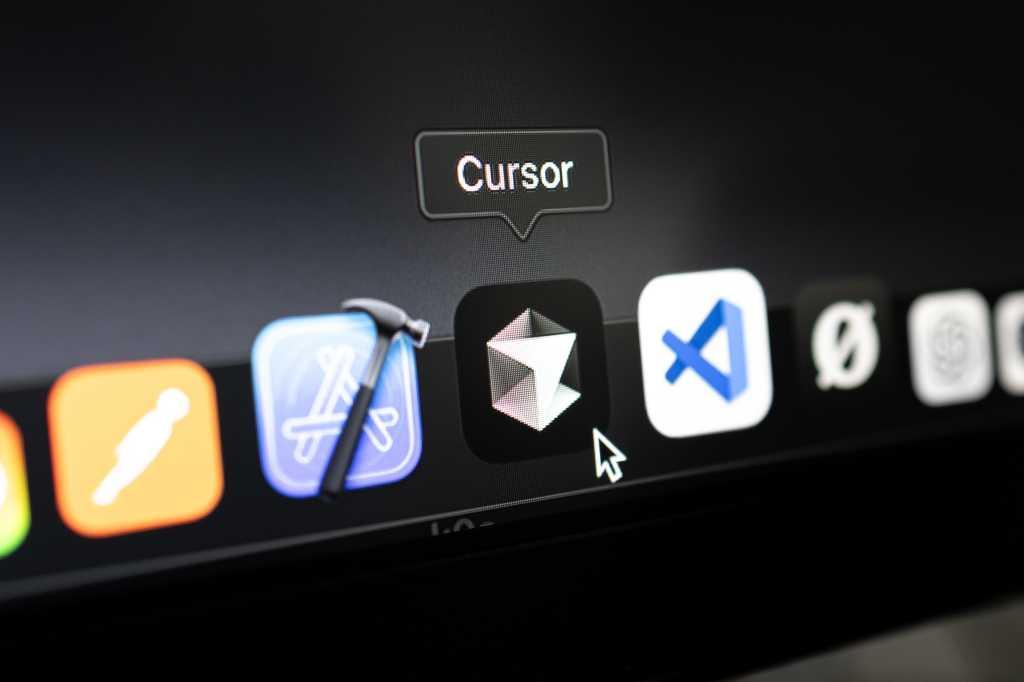Cursor AI: Revolutionizing Coding with Advanced AI Integration
2 Sources
2 Sources
[1]
How Cursor AI Editor Made Coding Easier For Me
It also completely removed LangChain dependency and handled embeddings using Gemini's latest documentation. The popular AI code editor, Cursor, is surely meant for developers, but it's also helping a novice coder like me to get started with new programming languages. Yes, I have done my fair bit of web programming during college, but I was not familiar with Python at all. Now, as a writer, I occasionally play with some scripts or tinker with Python code at best. So with the release of Cursor, I was curious if it could help me with an old Python project. Last year, I wrote a Python tutorial on how to train an AI chatbot on a custom database using OpenAI's API and LangChain. I was wondering if Cursor could migrate my code to Gemini's API and remove the LangChain dependency completely. To my surprise, Cursor, powered by Claude 3.5 Sonnet, successfully removed LangChain and OpenAI dependencies. Of course, it resulted in multiple errors, but after three rounds of code fixing, it resolved all errors. I had to simply paste the errors and ask for assistance. And the Composer window quickly made relevant changes to the code. Finally, I ran the Python code, and it worked like a charm. The Gradio interface was up and running without any issues. It even correctly added the Gemini 1.5 Flash endpoint and removed some UTF errors. Not to mention, it referred to Gemini's latest documentation to find a way to create and store the embeddings. All in all, I am very impressed with Cursor, especially when it's powered by the Claude 3.5 Sonnet model. It's arguably the best AI model right now for coding, besides the OpenAI o1 model. Surely, the new ChatGPT Canvas feature can also improve your code with revisions and bug fixes, but Cursor offers an integrated environment with a compiler. So if you are a developer looking for a powerful AI code editor, I would strongly recommend using Cursor. As for beginners, Cursor can help you with code, but deployment is another skill to learn. For now, all I can say is that you must have a cursory knowledge of programming to start using Cursor.
[2]
What is Cursor AI, the ChatGPT Replacement for Coding
Cursor also lets you debug code using AI. Overall, Cursor beats VS Code in providing an integrated AI experience. Cursor AI has taken the programming world by storm. Developers are replacing Microsoft's VS Code with Cursor as their favorite new IDE. It's being called a true AI code editor and folks like Andrej Karpathy, the former senior director of AI at Tesla, have praised it. Cursor has received funding from Andreessen Horowitz, Jeff Dean, John Schulman, Noam Brown, and the founders of Stripe and GitHub. But how is it different from GitHub Copilot in VS Code and what new features does Cursor bring? Let us understand it. First things first, Cursor is a fork of VS Code so it has a familiar interface and you can import all your extensions, themes, and keybindings in one click. It also offers its own 'cursor-small' AI model which is not a premium model but can be helpful for quick editing tasks. Apart from its small model, Cursor supports several premium models from OpenAI, Google, and Anthropic. You can use premium models like OpenAI o1, Claude 3.5 Sonnet, GPT-4o, GPT-4, Claude 3 Opus, and more. It also lets you add your API key which is great. Initially, Cursor is offering two weeks of free Pro trial that uses Claude 3.5 Sonnet for code completion and other tasks. The best part about Cursor is that it learns from your codebase and creates embeddings on your device to predict your next edit accurately. Just keep hitting 'Tab' to accept autocomplete suggestions. It surely boosts productivity by many folds. By the way, if you are worried about your data, you can choose private mode during the setup to opt out of training. It also lets you set rules for the AI editor. You can define file for each repo and Cursor will follow those instructions. For example, if you are writing an iOS app, you can define your rules and preferences for the Swift language. You can even define different AI rules for specific files. Now, comes the most vital feature of Cursor -- Composer. It can be triggered with the shortcut: Ctrl + K. In the Composer box, you can enter instructions in natural language and it generates code right there. Either select a code snippet or simply choose the current file, and ask for improvements or refactor the code. Press 'Ctrl + Enter' and quickly accept the suggestions. The best part about Composer is that you can use '@' in the Composer box to tag files, folders, web links, codebase, Git, etc., and add detailed instructions on what you want to achieve. You can even tag official docs from OpenAI, Microsoft, AWS, etc. It truly unlocks the potential of AI coding assistance. Apart from that, you can press Ctrl + L to open the chat window where you can ask questions, chat with your local codebase, and get code suggestions. Moreover, you can select a chunk of code and press the shortcuts to bring up the Composer or Chat window. You can now review the changes and add coding suggestions in no time. Finally, you can also debug the code using AI. It's well integrated within the environment and quickly tells you what changes to make in a Chat window. Overall, Cursor is a fantastic AI code editor, and with the Claude 3.5 Sonnet model, it really ups the game for coders.
Share
Share
Copy Link
Cursor AI, a fork of VS Code, is gaining popularity among developers for its powerful AI-driven features, including code generation, debugging, and seamless integration with premium language models.

Cursor AI: The Next-Generation Code Editor
Cursor AI, a fork of Microsoft's Visual Studio Code (VS Code), is making waves in the programming world as developers increasingly adopt it as their preferred Integrated Development Environment (IDE). This AI-powered code editor has garnered attention from industry leaders and received funding from notable figures in the tech world
2
.Key Features and Capabilities
Cursor AI distinguishes itself through several innovative features:
-
AI Model Integration: Cursor supports various premium AI models, including OpenAI's GPT-4, Anthropic's Claude 3.5 Sonnet, and Google's offerings. It also provides its own 'cursor-small' model for quick editing tasks
2
. -
Intelligent Code Completion: The editor learns from your codebase, creating embeddings on your device to predict and suggest accurate code completions
2
. -
Composer Feature: Activated with Ctrl + K, this tool allows developers to input natural language instructions and generate code snippets or refactor existing code
2
. -
Context-Aware Assistance: Users can tag files, folders, web links, and even official documentation to provide detailed context for AI-assisted coding
2
. -
AI-Powered Debugging: Cursor integrates AI capabilities into the debugging process, offering quick suggestions and explanations for code issues
2
.
Real-World Application
A novice Python programmer recently tested Cursor's capabilities by attempting to migrate an existing project from OpenAI's API and LangChain to Google's Gemini API. The experience highlighted Cursor's effectiveness:
-
Dependency Removal: Cursor successfully removed dependencies on LangChain and OpenAI, transitioning the code to use Gemini's API
1
. -
Error Resolution: Through multiple rounds of code fixing, Cursor resolved all errors that arose during the migration process
1
. -
Up-to-Date Implementation: The AI referenced Gemini's latest documentation to correctly implement features like embeddings creation and storage
1
.
Related Stories
Impact on Coding Workflow
Cursor AI is positioned to significantly impact coding workflows:
-
Productivity Boost: The intelligent code completion and AI-assisted features can dramatically increase coding speed and efficiency
2
. -
Learning Tool: For beginners, Cursor serves as a valuable learning aid, helping them understand and implement new programming concepts
1
. -
Customization: Developers can set specific rules and preferences for the AI editor, tailoring its behavior to their coding style or project requirements
2
.
Privacy and Data Concerns
While Cursor offers powerful AI integration, it also addresses privacy concerns. Users have the option to choose a private mode during setup, which opts out of data collection for AI training purposes
2
.As AI continues to reshape the landscape of software development, tools like Cursor AI are at the forefront, offering developers powerful assistance while maintaining the flexibility and familiarity of traditional IDEs. While it presents a significant leap in AI-assisted coding, users should still possess fundamental programming knowledge to fully leverage its capabilities.
References
Summarized by
Navi
Related Stories
Cursor AI: The Revolutionary Coding Assistant Transforming Software Development
29 Aug 2024

Cursor AI Code Editor's 0.43 Update Introduces Advanced AI Agents, Challenging Competitors
26 Nov 2024•Technology

Cursor 2.0 Launches with Proprietary Composer Model, Promising 4x Faster AI-Assisted Coding
30 Oct 2025•Technology

Recent Highlights
1
OpenAI releases GPT-5.2 AI model after code red memo targets Google's Gemini 3 threat
Technology

2
Disney invests $1 billion in OpenAI, licenses 200+ characters for Sora AI video generator
Technology

3
OpenAI faces wrongful death lawsuit after ChatGPT allegedly fueled murder-suicide tragedy
Policy and Regulation




